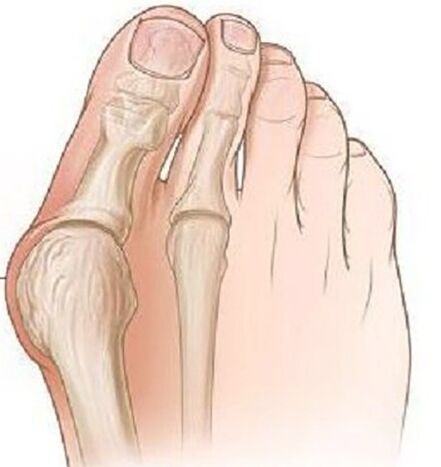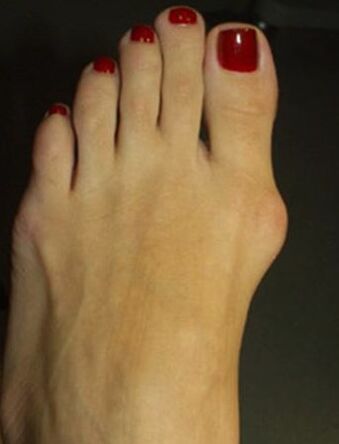Valgus deformation from the toes is the most frequently obtained deformation of the feet, characterized by the outdoor deviation.
Pathology is bilateral, especially affecting women for over 35 years.In most cases, deformation is accompanied by chronic inflammation of the joint bag and the deformation of the plusphalang joint arthrosis, the first metatarsal bone deviation.

Causes of disease.Why is it dangerous?
Causes of etiology of valgus deviation from the toes have not yet been fully studied.There are several theories of events:
- Vestigial Theory.In the mid -19th century, it is believed that only models subject to this deformation were due to the use of high -quality model shoes, but during this pathological study it was found in men wearing flat -sole shoes.
- Theory of major muscle weakness - has been denied in a detailed study of this problem.
- Theory of weakening of ligament apparatus and single aponeurosis deficiency - most scientists adhere to this theory.
There are several factors that lead to this pathological debut:
- Excessive weight increases the load on the feet.
- Dystrophic changes associated with age in ligament articular tools.
- Week of summer shoes are more than 5 cm, narrowing the feet.
- Deformation is on the frame (scoliosis, deformation of the femoral joint valgus and knees, flat feet).
The pathological danger lies in the fact that over time this deformation leads to posture deformation, it is possible to develop dystrophic-in the spine, hips and knees due to improper distribution during walking, and injury to the leg muscles is accompanied by persistent pain, which significantly worsens the better.
Clinical manifestations
At the beginning of the disease, the deformation of the valgus does not manifest itself clinically.Most women are more concerned about the appearance of the feet-the level of the metacarpal-phalanx joints and the first explosion becomes significant.

Over time, pain occurs, first when wearing narrow shoes and prolonged walking, and then the pain begins to remain, it hurts.
Due to improper weight distribution, the limbs, by the first and second fingers on the one, formed by corn, the second finger is raised, highly extended, the fingers of "Malleus" are formed, which is very complicated.Due to the deterioration of blood circulation and conservation in the anterior part of the foot, arthrosis and chronic bursitis develop.
Diagnostics
- During objective examination, the classic deformation with the deviation of the thumb valgus is visible, the distal part of the foot is expanded.In the first metatarsal bone head projection, there are signs of bursite - hyperemia and skin edema, pain during palpation.
- Radiography of the foot in two projections.The front projection determines the level of the thumb, the condition of the metacarpal-phalanx joints, the level of sesamoid bone displacement, and in the lateral projection of the flat foot level is described and calculated, which often occurs with the deviation of the first leg valgus.
- Plantography.On foot prints, made on paper, lines are drawn through the heel center and between the fourth and third fingers, the exterior sets are formed, according to the presence of the feet and degrees.In these patients, flat feet or flat feet from the first degree are more frequently detected.
Treatment and prevention
Depending on the severity of the process, conservative treatment or surgery is performed.
Conservative treatment is carried out at the mild stage of the disease, various types of orthopedic insoles are used, individually selected and carry defective fingers to normal positions, while the load on the front of the limbs is stable and distributed.
In the days of children and senile, the distal members of the distal member by putting between the first and second fingers were used.To reduce pain, warm baths with sea salt and soda are used, radon baths provide good results.
To combat bursitis, local anti -inflammation gel, compress with dimexide and lidocaine is used, and with clear pain, novocaine blockade and intraarticular injection glucocorticoids are used.

Surgical treatment is possible anywhere in the disease, it is performed under local anesthesia, which reduces the list of contraindications to surgery.
In the first stage, cold bone growth is released on the edge of the bone, while it is only possible to reduce the pain of the process, but does not prevent the development of deformation in the future.
With severe finger deviation with the presence of flat feet, osteotomy is performed at the base of the bone plus the first finger using the bone blade to push the finger to the normal position, with the help of lavan tape, a single horizontal ligaments are formed.After surgery, the feet are strictly set with 4 weeks, it is recommended to use individual orthopedic insoles throughout the year.
Prevention of the disease is to use comfortable shoes without high heels, shoes should sit on the feet freely, narrow toes cannot bring discomfort to the thumb.In the event of any deformation of the framework, it is recommended to undergo a preventive examination in orthopedis to identify and slow down the development of valgus deformation from the foot.
Consequences and complications
The complications of the process are the development of deichländer or the "parade" of the foot, characterized by acute pain, due to microcess in the pair of pair and tendovaginitis.
Due to the ongoing inflammatory process and mechanical damage, there is a risk of developing malignant malignant neoplasms.























